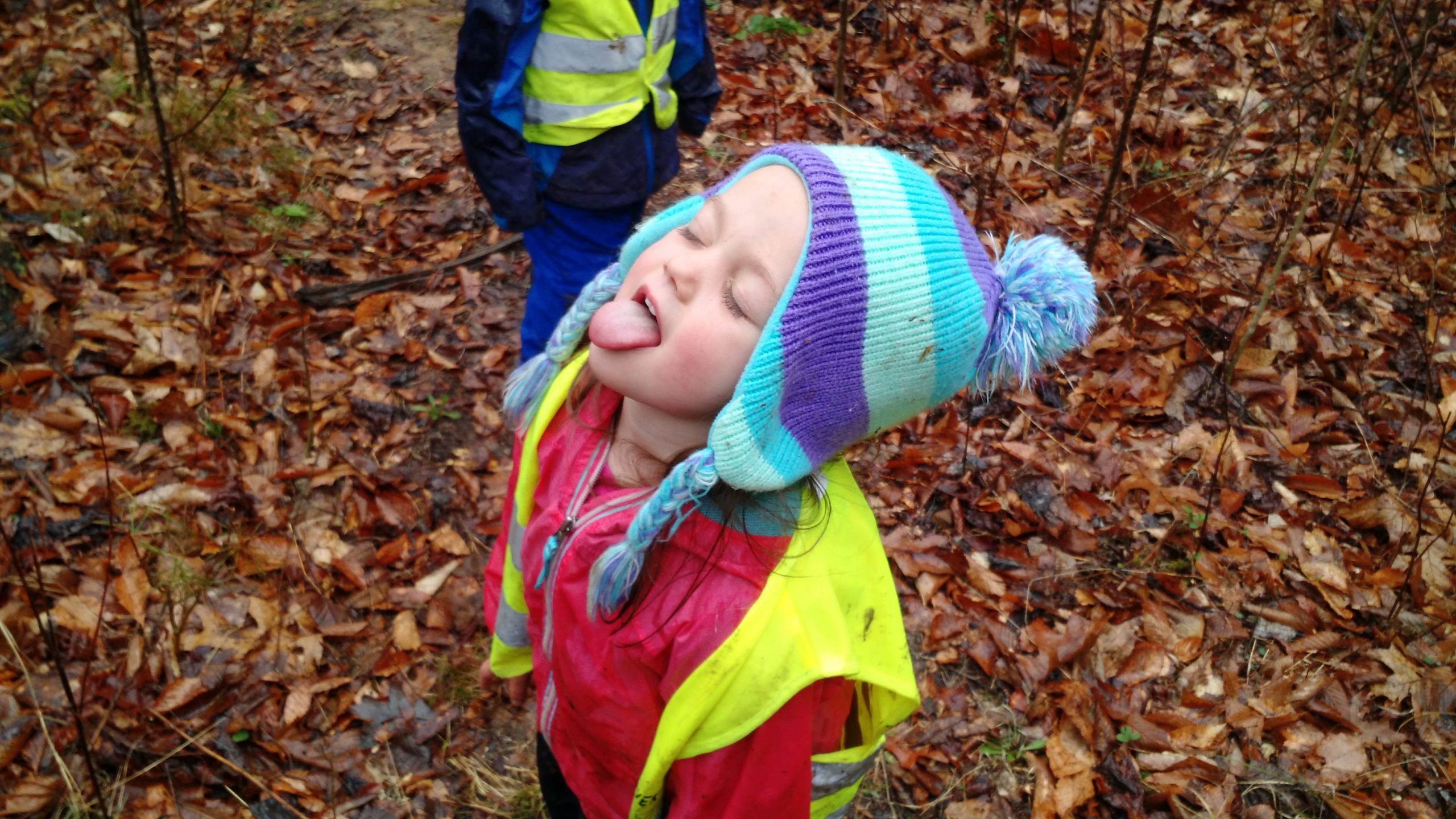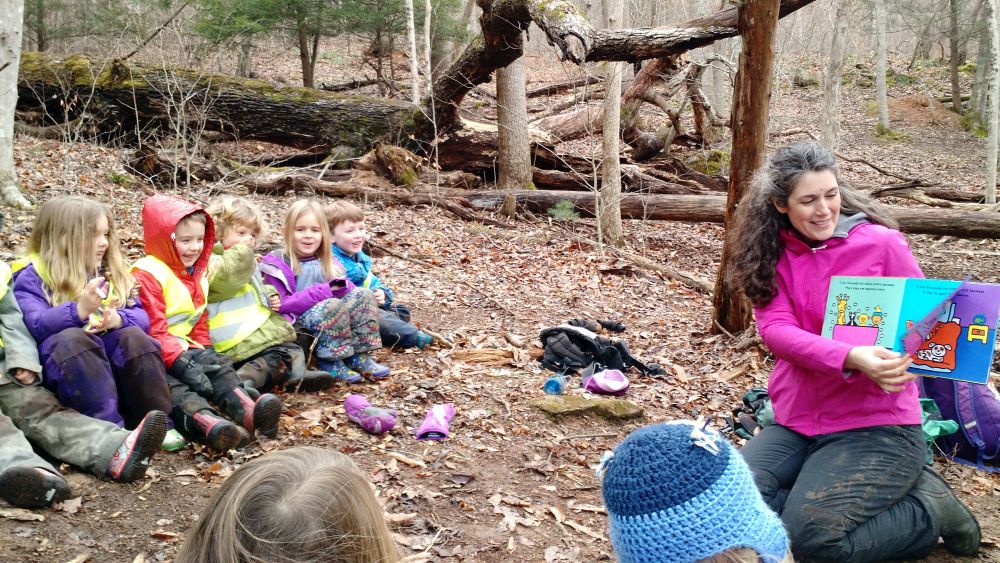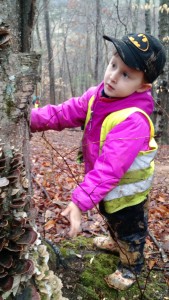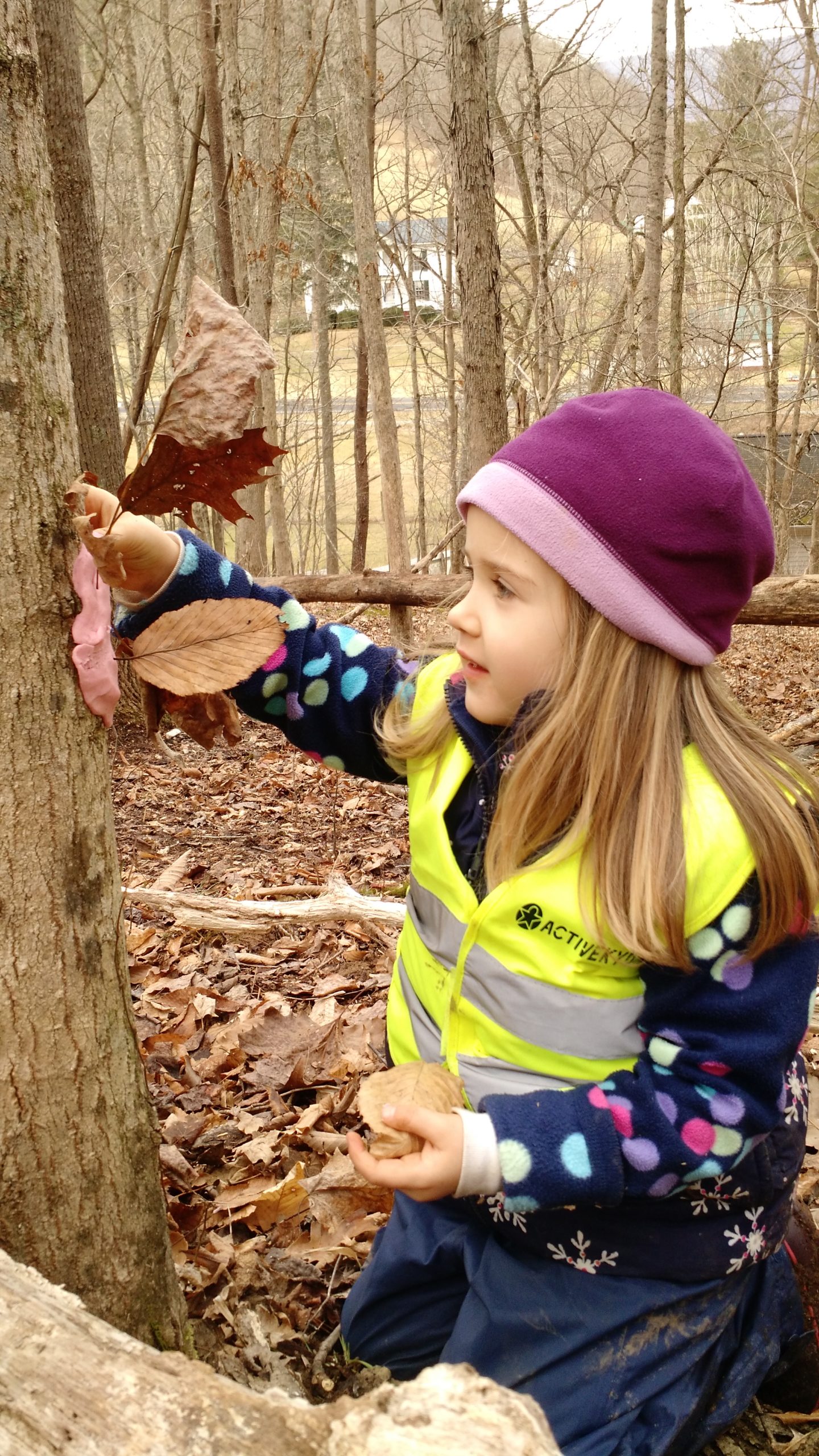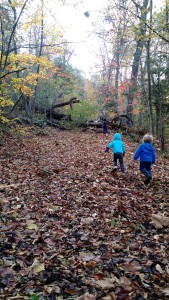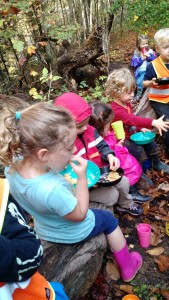Fifteen children cross the wooden bridge over the creek and wend their way up a steep switchback into the forest. Soon they’ll be immersed in a self-created game of “Castle and Dragons,” taking breaks to exclaim over found mushrooms and animal tracks. Letting the children loose to create their own rich play worlds is a dreamy reality, possible only when children are comfortable being in the forest.
As a teacher, I do have the sense that I can’t fully plan our forest adventures, whether play session or hike, because nature and our nature discoveries change with each visit. I’m also aware that I shouldn’t always try to plan for children’s play and experiences, because their own planning is what builds important executive functioning skills. But when children are first introduced to wild places, they need to build their comfort levels before they can take on this kind of play. Building comfort levels is something you can plan for, and I’ve included a few forest activities that have worked for The Mayapple School students below.
Feel free to use this as a resource for your own planning or as a reminder to jot down your own thoughts about what has worked for your group. I always think I’ll remember what I’ve learned the previous school year, but after a few Augusts spent thinking, “Now, how did I do that again?” I know better. Hopefully this list will help!
Eight Forest Activities That Help Create Children Who are Comfortable in Nature
- Read a book – Before I began taking preschoolers into the forest, I read somewhere the idea that to hold a program in nature, you couldn’t just take what you were doing inside and bring it outside—a real nature program would be fundamentally different. When it actually comes time to implement your program, this statement is intimidating. Feel free to ignore it. Taking the things you do inside and bringing them outside will help create instant comfort for your child or students. A familiar book or favorite game brings familiarity to the unknown. Just be very aware it’s a lot harder to keep track of possessions in the forest! (And yes, with enough experience, your program will evolve so that it doesn’t look the same as just bringing your indoors program outside. But starting from the experience you already have is the perfect start.) There’s also LOTS of wonderful books about the forest, which you can share both while in the forest and before and after visits too.
- Have an off-trail picnic – Most children are more comfortable and experienced with trails and open places outdoors, and the first times visiting forest without trails can be very intimidating. Getting to know different pockets of trail-less forest can make traversing them easier. Sharing food with loved ones is one of our most enjoyable everyday activities, and bringing a picnic into the forest not only brings comfort to the unknown, but also gives children time to look around before they are challenged to interact with the environment.
- Make a map – Do you remember what it felt like to be in the forest before you had gained environmental literacy? The landscape was an uncomprehending blur of browns and greens, and because you couldn’t “read” even basic environmental cues, you were liable to walk right into briars, get easily turned around and afraid of getting lost, and worry about unknowns like wild animals. One way to increase child confidence is to make a simple relational representation of special spots that you go to in the forest, with a familiar point on the map, too. After you’ve visited a few different places in the forest, you can have children create directions to the day’s chosen destination, using the map. Now, it’s their job to lead you! I’ve found that even those children who had been asking “are we lost?” were able to give me correct directions. Our mapmaking days were among the most important comfort-building days this fall
- Bring art materials to the trees – Before environmental literacy, the landscape is a blur. In forest education, you are asking the students to stop and really look at what they see, turning the blur into recognizable forms and patterns. Without some sense of order, there can be no comfort in the environment beyond the reach of the caregiver’s arms (this is true indoors and out). Using a paint brush and non-toxic “mud paint,” with or without added coloring, children enjoy painting the bark of the trees. In this exploration, they get to know the trees in a slowed down, intimate way. Playdough offers similar benefits. Many imprints, like those of ferns and rocks, can be taken and the dough reused—or playdough can be used to make faces on trees and leaf and twig sculptures. The children begin thinking about the available materials in the forest as friendly and useful. Art, like sensory and loose parts play, also allows children to cause changes based on their actions, which can be very empowering.
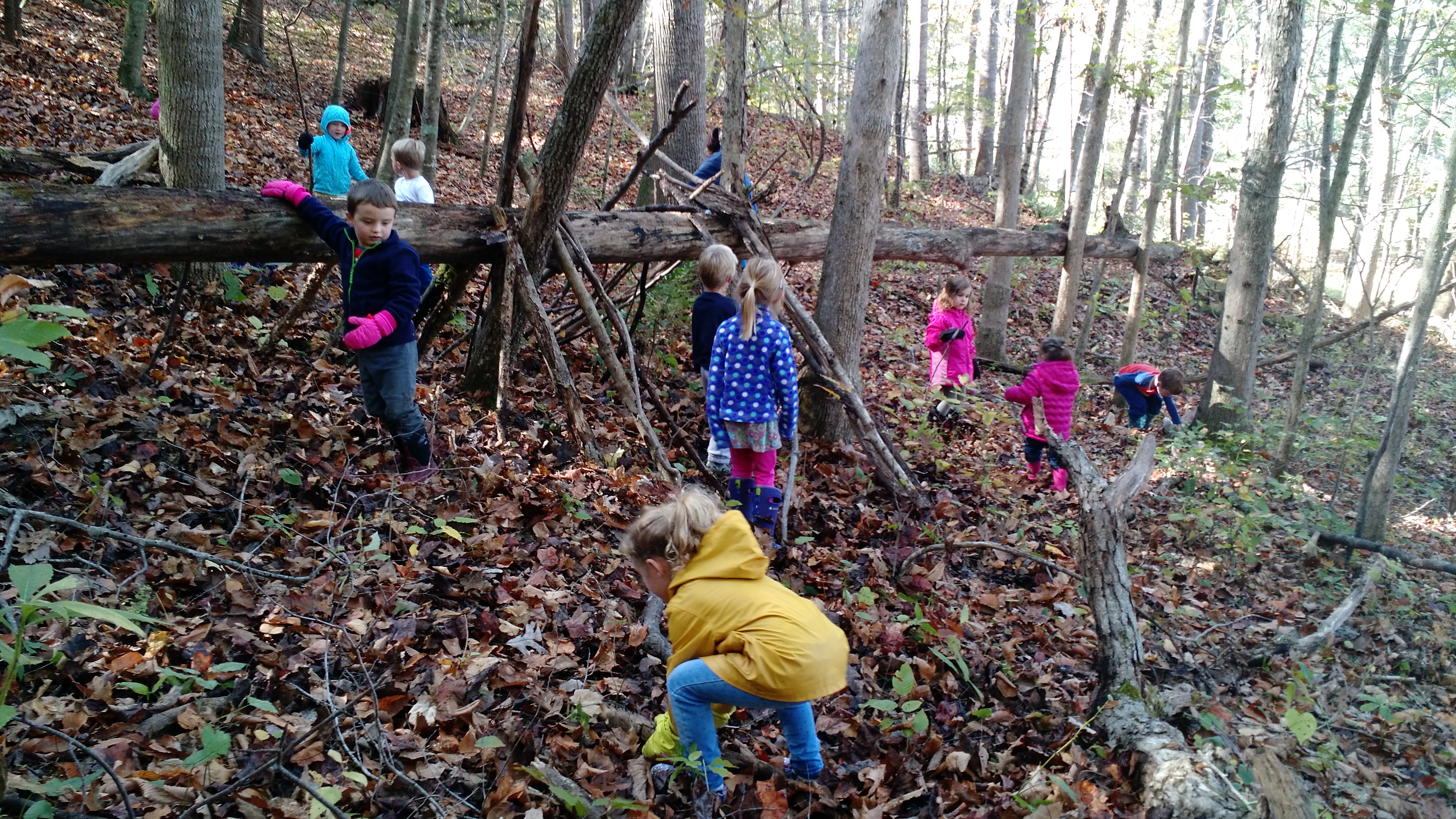
- Build a fort –Building is fun, gets children thinking about forest adventure positively, and the result offers a place for pretend and nature play, a great base for building even more nature comfort. The landscape now has an anchor that is understandable to the child because she created it. Building a fort can be an absorbing endeavor, but also a time intensive one. Unless you have an older child or lots of children, expect to work hard alongside your child while building. As always, children will learn the most if they are involved in the planning process too.
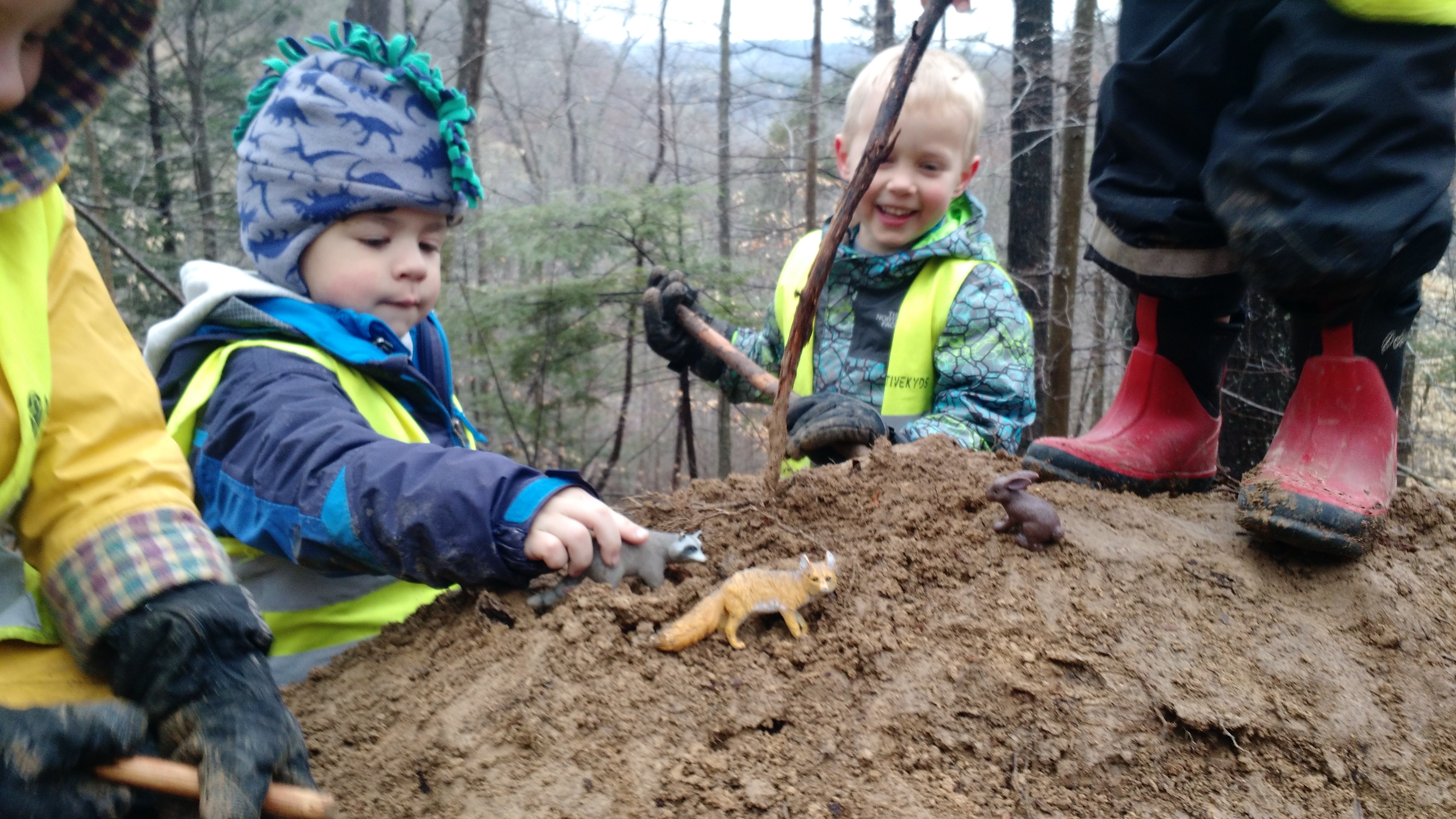
- Create a Small World– Small worlds allow the children to experience a lot in a small space with the protection of living semi-vicariously through their small world creatures. Favorite plastic figures such as dinosaurs or woodland mammals are now the ones exploring the landscape. To increase conversation and wow factor, bring baking soda & vinegar volcano materials into the forest with you and make dirt volcanoes as challenges for your small world creatures.

- Play Pretend – If you’ve ever watched a group of children play “make believe” before, you’ve probably noticed the enviable state of flow that they can achieve. You want them to experience this flow in the forest, and encouraging pretend play could be the best way to do it. At The Mayapple School, we read a fairy tale or other picture book with a narrative storyline (such as Kate and the Beanstalk) and, with adult facilitation, we ask the students to take on the roles of the characters within the book during their weekly “Play Together Game,” which takes place in the forest. For some students, this is easily their favorite part of school, and it is something that is asked for frequently. You will need more than one child of at least preschool age for this activity, but you can let the forest provide the props.
- Look for ___(insert nature item here)____ — Preschoolers at The Mayapple School LOVE guidebooks. They seem to have an insatiable need to name everything and know what it is. Now, I know what you’re going to say. The problem with opening up today’s date in your Nature-Activities-for-Every-Day-Of-The-Year book is that half of the dates ask you to look for turtles, ladybugs, mushrooms, or whatever the nature du jour is. And I can almost hear you crying– “but what if I don’t find anything!” Most of the activities I gave you don’t ask you to look for (or find) anything. But, sometimes it’s worth it to search. One day last spring after a detailed lesson on galls, we went into the forest to look for them. We found literally dozens of galls on that same day, even though we had never found one previously. We hadn’t found them because we weren’t looking, but once we were oriented to look for them, voila! Also, sometimes you just find cool stuff even when you’re not looking, so guidebooks can come in handy. Guidebooks are “real” tools that adults use and they make everything seem scientific. Looking for specific living or nonliving things promotes a sense of discovery, spirit of exploration, and awe in both children and adults.
There are many more activities to do with children in nature. You’ll soon find yourself saying, “How can this (previously indoors) activity be better outdoors?” and experimenting to find out. And soon after that, you’ll let loose your children with nothing but the features of the landscape and each other, and it will be enough to enthrall them in purposeful play until lunch time.
Until then, a caveat about the above activities: every time you visit wild places, you make an impact on them, even if it is just your footprints. Although most ecosystems can handle the impacts of child’s play, it’s important to check with the land owners or stewards to make sure your activity is allowed. Our everyday use of the earth, from driving a vehicle on paved roads to heating our houses and cooking with fossil fuels, impacts the earth much more than playing in the woods with our children could. Yet often these woods must also serve as a nature haven for many more humans than is reasonable to ask of it, as well as animals, and there is often a need to treat certain places very gently as a result.

